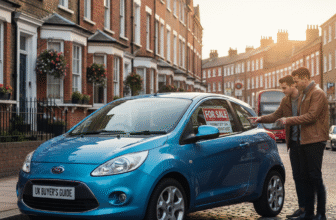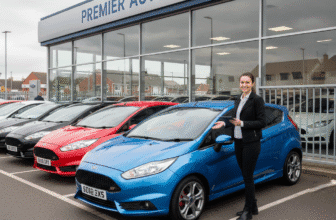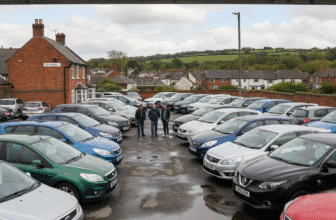
The Ultimate Guide to Finding the Perfect Used Car for Sale Near You in the UK
The thrill of getting a new car is undeniable, but the savvy buyer knows that the pre-loved market is where the real gems are found. Buying a used car in the UK can save you a significant amount of money, but it’s a journey that requires a bit of know-how to navigate successfully. That nagging search for a “used car for sale near me” is the first step on an exciting road. This guide is your trusted co-pilot, designed to steer you through the entire process, from initial search to driving away with a reliable and affordable vehicle that perfectly suits your needs. We’ll explore the best places to look, the crucial checks to make, and the art of negotiating a deal that leaves you smiling.
Where to Begin Your Search: Beyond the Obvious
In today’s digital age, your quest for a nearby used car will almost certainly begin online. However, not all platforms are created equal, and the traditional methods still hold significant value. Let’s break down your options.
Online Marketplaces: The Digital Forecourt

Websites like Auto Trader, Motors.co.uk, and Gumtree are the titans of the online used car world. They offer an unparalleled selection of vehicles from both private sellers and dealerships across the country. The search filters are your best friend here. You can narrow down your options by make, model, price, mileage, fuel type, and, most importantly, distance from your location. Don’t just stick to the big names, though. Niche online communities and forums, such as PistonHeads, can be goldmines for specific types of vehicles, particularly performance or classic cars, often sold by genuine enthusiasts who have meticulously cared for their pride and joy.
Facebook Marketplace has also emerged as a major player. While the platform is more informal, you can find some incredible bargains. However, it requires a greater degree of caution. Scrutinise seller profiles and be wary of deals that seem too good to be true. Always arrange to meet in a safe, public place and never transfer money before seeing the vehicle.
Franchised Dealerships: The Approved Used Promise
If peace of mind is your top priority, the ‘Approved Used’ scheme offered by franchised dealerships is hard to beat. These are vehicles from a specific manufacturer, such as Ford, BMW, or Volkswagen, that have been rigorously inspected and prepared to a high standard. They typically come with a comprehensive warranty, breakdown cover, and a full service history. While the initial purchase price might be slightly higher than from an independent dealer or private seller, the included benefits and the assurance of quality can make it a very worthwhile investment. You’re not just buying a car; you’re buying confidence.
Independent Used Car Dealers: A Spectrum of Choice
Independent dealers are the backbone of the UK’s used car market. They range from small, family-run forecourts to large, multi-site operations. The quality and service can vary, so it’s essential to do your homework. Look for dealers with a solid local reputation. Check online reviews on platforms like Google and Trustpilot. A good independent dealer will have a wide variety of makes and models, offer competitive pricing, and be transparent about the vehicle’s history. They are also more likely to be flexible on price compared to a franchised dealer.
Private Sellers: The Potential for a Great Deal
Buying from a private seller can be the most cost-effective way to get your hands on a used car. You cut out the middleman, and you’re often dealing with the person who has driven and maintained the car for years. This can provide invaluable insight into its history. However, this route comes with the least protection. The principle of ‘caveat emptor’ (let the buyer beware) very much applies. All sales are final, and you have fewer legal rights if something goes wrong. This is where your own checks and diligence become absolutely paramount.
The All-Important Checks: Your Pre-Purchase Checklist
Found a car you like? Brilliant. Now, it’s time to put on your detective hat. A thorough inspection can save you from a world of future headaches and unexpected repair bills. Don’t be shy; a reputable seller will understand and welcome your scrutiny.
The Paperwork Trail: More Than Just a Logbook
Before you even look at the car, ask to see the paperwork. This is non-negotiable.
- The V5C Logbook: This is the single most important document. Check that the name and address of the seller match the details on the V5C. Ensure the Vehicle Identification Number (VIN) and engine number on the document correspond to the numbers on the car itself (you can usually find the VIN at the base of the windscreen and on a plaque inside the driver’s door jamb).
- MOT Certificate: In the UK, cars over three years old require an annual MOT test. Check the expiry date on the current certificate. More importantly, go to the official GOV.UK website to check the vehicle’s entire MOT history online for free. This is a treasure trove of information, revealing past failures and advisories, which can highlight recurring issues.
- Service History: A full or partial service history is a huge plus. It shows the car has been looked after. Look for stamps from reputable garages. If the seller has serviced the car themselves, ask for receipts for parts and oil.
The Vehicle History Check: Your Secret Weapon
This is a step you absolutely cannot afford to skip, especially when buying privately. For a small fee, companies like HPI, The AA, and the RAC will run a comprehensive background check on the vehicle. This will tell you:
- If there’s outstanding finance: If you buy a car with outstanding finance, it could be repossessed, leaving you out of pocket and without a vehicle.
- If it’s been recorded as stolen: You do not want to inadvertently buy stolen goods.
- If it’s been written off by an insurer: A ‘write-off’ (or ‘salvage’ vehicle) can be repaired and returned to the road, but its history affects its value and safety. A history check will reveal this crucial information.
- If there’s a mileage discrepancy: The check compares the current mileage with previously recorded data to flag potential ‘clocking’.
The Physical Inspection: A Hands-On Approach
Now for the car itself. Go through it with a fine-tooth comb, ideally in dry, daylight conditions.
- Bodywork: Look for signs of rust, dents, and scratches. Check for inconsistent gaps between panels, which could indicate a poor repair job. Look for variations in paint colour and texture. A small magnet can help you detect areas filled with body filler.
- Tyres: Check the tread depth – the legal minimum is 1.6mm across the central three-quarters of the tyre. Look for uneven wear, which could signify tracking or suspension issues.
- Under the Bonnet: Check the oil level and colour using the dipstick. Look at the coolant level. Check for any obvious leaks. You don’t need to be a mechanic, but look for anything that seems out of place or neglected.
- Interior and Electrics: Sit inside and get a feel for the car. Check that all the switches and buttons work – windows, wipers, lights, air conditioning, radio, etc. Look for excessive wear on the steering wheel, gear stick, and pedals, as this could suggest the mileage is higher than stated.
The Test Drive: The Moment of Truth
A test drive is more than just a quick spin around the block. It’s your chance to assess how the car performs in real-world conditions. Before you set off, make sure you are properly insured. A dealer’s policy will usually cover you, but if you’re buying privately, you’ll need to check your own insurance policy for ‘driving other cars’ cover, or arrange temporary insurance.
During the test drive, pay attention to:
- The Engine: Does it start easily from cold? Are there any strange noises or rattles?
- The Brakes: Do they feel responsive? Does the car pull to one side when you brake?
- The Steering and Suspension: Does the steering feel accurate? Listen for any clunks or bangs when going over bumps.
- The Clutch and Gearbox: Does the clutch bite at the right point? Are the gear changes smooth?
Try to drive on a variety of roads, including a stretch of dual carriageway if possible, to see how the car handles at different speeds.
The Art of the Haggle: Negotiating the Best Price
So, you’ve done your checks, taken a test drive, and you’re happy this is the car for you. Now it’s time to talk money. Negotiation is expected in the used car market, so don’t be afraid to make a sensible offer.
Your research is your power. Use any issues you’ve found – whether it’s a short MOT, worn tyres, or minor cosmetic damage – as leverage to negotiate a lower price. If the car needs two new tyres, for example, get a quote for the cost and ask for that amount to be deducted from the asking price. Be polite, be reasonable, and be prepared to walk away if you can’t agree on a price you’re happy with. There will always be other cars.
Sealing the Deal: The Final Steps
Once you’ve agreed on a price, it’s time to finalise the purchase. Never pay with a large amount of cash. A bank transfer is the safest method for both parties, as it creates a clear digital record of the transaction. Before you hand over any money, make sure you get a written receipt that includes the date, the price, the vehicle’s details (registration and VIN), and the names and addresses of both you and the seller.
The seller needs to complete the relevant section of the V5C logbook to transfer ownership to you. Nowadays, this can often be done online via the GOV.UK website, which is the quickest and easiest method. You will receive the ‘new keeper’s supplement’ (V5C/2) from the logbook, and the DVLA will send you a new V5C in your name within a few weeks.
Finally, don’t forget the two crucial legal requirements before you can drive your new car home: it must be taxed in your name, and you must have valid insurance. Both can be arranged online or over the phone in a matter of minutes. It is illegal to drive a car without tax and insurance, even for the journey home.
Finding the perfect used car near you is an achievable and rewarding experience. It’s about combining diligent research with a hands-on approach. By following these steps, you can filter through the thousands of listings, identify a reliable vehicle, and negotiate a fair price with confidence. The open road awaits in your fantastic, affordable, and wisely chosen used car.







